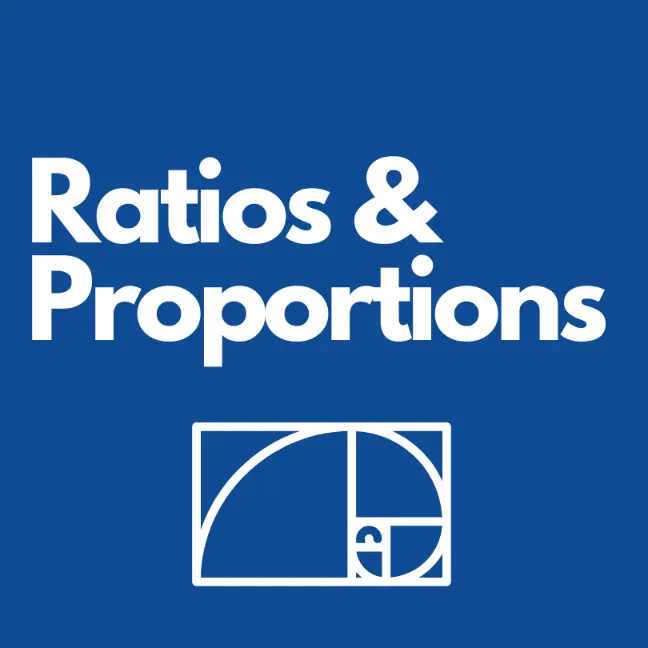Golden Ratio Calculator
- Enter just one number to create a golden ratio or,
- Enter both A and B for comparison or,
- Enter both A+B and A for comparison
Related Ratio & Proportion Calculators
See all maths calculators
1. Golden Ratio: what is it?
The Golden Ratio, often represented by the Greek letter Phi (φ), is a special number approximately equal to 1.618. It's derived from a mathematical proportion where a line is divided into two segments (A and B) such that the ratio of the whole line (A + B) to the longer segment (A) is equal to the ratio of the longer segment (A) to the shorter segment (B).
2. Working examples of the Golden Ratio
a. Golden Rectangle
A Golden Rectangle is a rectangle where the ratio of its length to its width is precisely the Golden Ratio (φ ≈ 1.618).
In Construction:
- Square: Draw a square with sides of length 1 unit (AB = BC = CD = DA = 1).
- Midpoint: Find the midpoint (E) of one side (AB).
- Diagonal: Draw a line (EC) from the midpoint (E) to an opposite corner (C).
- Extend Base: Extend the base (AB) to the right.
- Arc: With center E and radius EC, draw an arc that intersects the extended base at point F.
- Golden Rectangle: Rectangle AFCD is a Golden Rectangle.
Calculation:
- Square Side (AB): 1 unit
- Half-Square Side (EB): 0.5 units
- Diagonal (EC): √(1^2 + 0.5^2) = √1.25 ≈ 1.118 units (Pythagorean Theorem)
- Golden Rectangle Length (AF): 1 (AB) + 1.118 (EF) = 2.118 units
- Golden Rectangle Width (AD): 1 unit
- Length/Width Ratio (AF/AD): 2.118 / 1 ≈ 2.118 (approximately the Golden Ratio, φ)
Unique property of the Golden Ratio:
The Golden Rectangle has a unique property: If you remove a square (ABEF) with side length equal to the width of the rectangle, the remaining rectangle (ECDF) is also a Golden Rectangle. This process can be repeated infinitely, producing smaller and smaller Golden Rectangles within each other.
b. Golden Triangle
A Golden Triangle is an isosceles triangle where the ratio of the length of the longer side to the shorter side is the Golden Ratio (approximately 1.618).
In Construction:
- Draw an equilateral triangle.
- Bisect one of the angles.
- Extend the bisector until it intersects the opposite side.
- Connect this intersection point to one of the other vertices of the original triangle. This creates a Golden Triangle.
c. Golden Angle
The Golden Angle is approximately 137.5 degrees. It's derived from dividing a circle into two arcs such that the ratio of the larger arc to the smaller arc is the Golden Ratio.
In Construction:
- Draw a circle.
- Divide the circle's circumference into two arcs with a ratio of approximately 1.618. The resulting smaller angle is the Golden Angle.
d. Pentagram
A pentagram (five-pointed star) contains multiple instances of the Golden Ratio.
- The ratio of a pentagram's diagonal to its side is the Golden Ratio.
- The intersections of the diagonals create smaller Golden Triangles within the pentagram.
e. Golden Ratio in Typography
In typography, the Golden Ratio can be used to create visually pleasing proportions in font sizes and line spacing.
- If the body text font size is 12 points, the heading font size could be calculated as 12 * 1.618 ≈ 19.4 points.
f. Golden Ratio in Logo Design
Many logos incorporate elements that approximate the Golden Ratio to achieve a visually balanced and aesthetically pleasing design.
- The Pepsi logo is often cited as an example where the Golden Ratio is used to determine the proportions of the curves and circles within the design.
3. Golden Ratio in Schools & Colleges
a. Geometry
- Geometric Constructions: The Golden Ratio is integral to constructing various geometric shapes, most notably the Golden Rectangle and Golden Spiral (as previously explained). Students can learn to create these shapes using only a compass and straightedge, reinforcing fundamental geometric principles.
- Proofs and Theorems: The Golden Ratio appears in several geometric proofs and theorems. For example, students can explore how it relates to the properties of pentagons and pentagrams, where the ratio of a diagonal to a side is the Golden Ratio.
- Trigonometry: The Golden Ratio can be linked to trigonometric functions and angles within certain geometric shapes, offering opportunities for advanced mathematical exploration.
b. Art Classes
- Composition: The Golden Ratio can be used as a guide for composition in visual arts. Artists may divide their canvas or artwork into sections based on the Golden Ratio to determine the placement of focal points, leading lines, and other elements. This can create a sense of balance and visual harmony.
- Aesthetics: The Golden Ratio is often associated with beauty and aesthetic appeal. Students can analyse famous artworks and architecture to see how the Golden Ratio has been applied, whether consciously or subconsciously, to achieve pleasing proportions.
- Design Principles: The Golden Ratio can be incorporated into design principles, such as the Rule of Thirds in photography, which divides a frame into thirds both horizontally and vertically. The points of intersection are considered visually appealing areas to place key elements.
c. Science
- Phyllotaxis: This term refers to the arrangement of leaves on a plant stem. The Golden Ratio often appears in phyllotaxis patterns, as leaves tend to grow in a spiral pattern that optimizes sunlight exposure and minimizes overlap. Students can study plant specimens and observe this phenomenon first hand.
- Seed Heads and Flowers: The arrangement of seeds in flower heads, such as sunflowers, often follows a Fibonacci spiral, closely related to the Golden Ratio. This arrangement allows for the most efficient packing of seeds within the limited space.
- Animal Proportions: While not as prevalent as in plants, some studies suggest that the Golden Ratio might be present in the proportions of certain animal bodies, such as the spiral shape of a nautilus shell.
4. Golden Ratio in Work/Life
a. Design
- Architecture: Architects have used the Golden Ratio for centuries to create harmonious and aesthetically pleasing structures. The Parthenon in Athens, for instance, is believed to incorporate the Golden Ratio in its design. Modern architects may also use it to determine the proportions of windows, doors, and other elements in a building.
- Product Design: The Golden Ratio can be applied to the design of everyday objects to make them more visually appealing and user-friendly. For example, the dimensions of a smartphone or the arrangement of buttons on a remote control might be based on the Golden Ratio.
- User Interfaces (UI): UI designers can leverage the Golden Ratio to create layouts that are both attractive and intuitive. The placement of menus, icons, and content blocks can be guided by the Golden Ratio to enhance user experience.
b. Photography
- Composition: The Golden Ratio can be a valuable tool for photographers when composing a shot. By dividing the frame into sections based on the Golden Ratio, photographers can determine ideal placement for the subject and other elements. This technique is often used to create visually balanced and engaging photographs.
- The Rule of Thirds: The Rule of Thirds is a simplified version of the Golden Ratio that's widely used in photography. It involves dividing the frame into thirds horizontally and vertically, with the idea that placing the subject at one of the intersections creates a more dynamic and interesting composition.
- Cropping: The Golden Ratio can also be applied when cropping photos. By cropping to a Golden Rectangle, photographers can often enhance the visual appeal of an image.
c. Personal Finance
- Fibonacci Retracement: In technical analysis of financial markets, Fibonacci retracement is a method that uses horizontal lines to indicate areas of support or resistance based on Fibonacci ratios (which are derived from the Fibonacci sequence and closely related to the Golden Ratio). Traders may use these levels to identify potential reversal points in a stock's price movement.
- Disclaimer: It's important to emphasize that Fibonacci retracement is not a foolproof method for predicting market movements. It's just one tool among many that traders use, and its effectiveness is subject to debate. It should not be relied upon as the sole basis for making financial decisions.
5. Golden Ratio - FAQs
1. What is the Golden Ratio?
The Greek letter Phi (), which stands for the Golden Ratio, is approximately 1.618. It's a mathematical proportion where a line is divided into two segments so that the ratio of the whole line to the longer segment is the same as the ratio of the longer segment to the shorter segment. This ratio appears repeatedly in nature, art, and architecture.
2. Why is the Golden Ratio considered special?
The Golden Ratio is considered special for several reasons:
- Aesthetics: It's often associated with visual harmony and beauty. Many artists and architects have used it to create pleasing proportions in their work.
- Natural Occurrence: It appears surprisingly often in nature, from the arrangement of petals on a flower to the proportions of the human body.
- Mathematical Properties: It has unique mathematical properties, like its connection to the Fibonacci sequence.
3. How is the Golden Ratio connected to the Fibonacci sequence?
The Fibonacci sequence is a series of numbers where each number is the sum of the two preceding ones (0, 1, 1, 2, 3, 5, 8, 13, and so on). As you go further along in the sequence, the ratio between consecutive numbers gets closer and closer to the Golden Ratio (approximately 1.618).
4. Can I find the Golden Ratio in everyday objects?
Yes! Look for rectangles whose sides are in a ratio close to 1.618. You might find them in the proportions of books, credit cards, or even some architectural features. You can also try spotting spiral patterns in nature that resemble the Golden Spiral, derived from the Golden Ratio.
5. How do artists and designers use the Golden Ratio?
Artists and designers often use the Golden Ratio to create visually pleasing compositions. They might apply it to the layout of a painting, the proportions of a logo, or the arrangement of elements on a webpage. It's a tool that can help guide their creative choices.
6. Is the Golden Ratio really a "divine" or "perfect" proportion?
While the Golden Ratio has been associated with beauty and harmony, there's no scientific proof that it's a universally "perfect" proportion. Beauty is subjective, and different cultures and individuals have varying preferences. However, the Golden Ratio's prevalence in nature and art suggests that it holds a certain appeal to many people.
7. Can the Golden Ratio predict financial markets?
Some traders use a technique called Fibonacci retracement, based on the Golden Ratio, to try and predict price levels in financial markets. However, it's important to note that this is just one of many tools used in technical analysis, and its effectiveness is debated.
8. Are there any criticisms or controversies about the Golden Ratio?
Some critics argue that the Golden Ratio's significance in art and nature has been exaggerated or even misrepresented. They point out that it's not always easy to find precise examples of the Golden Ratio in real-world objects, and that beauty is subjective.

